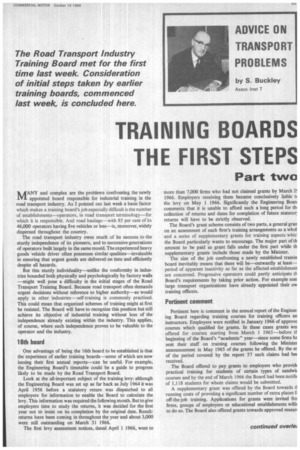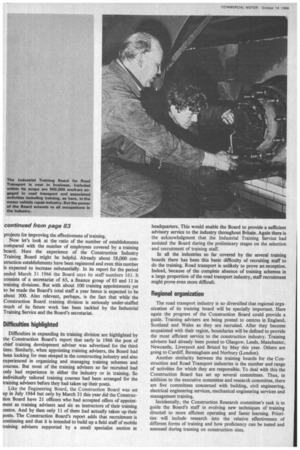TRAINING BOARDS THE FIRST STEPS
Page 85

Page 86

If you've noticed an error in this article please click here to report it so we can fix it.
Part two MANY and complex are the problems confronting the newly appointed board responsible for industrial training in the road transport industry. As I pointed out last week a basic factor which makes a training board's job especially difficult is the number of establishments—operators, in road transport terminology—for which it is responsible. And road haulage—with 85 per cent of its 46,000 operators having five vehicles or less—is, moreover, widely dispersed throughout the country.
The road transport industry owes much of its success to the sturdy independence of its pioneers, and to successive generations of operators built largely in the same mould. The experienced heavy goods vehicle driver often possesses similar qualities—invaluable in ensuring that urgent goods are delivered on time and efficiently despite all hazards.
But this sturdy individuality—unlike the conformity in industries bounded both physically and psychologically by factory walls —might well pose a difficulty in the initial stages of the Road Transport Training Board. Because road transport often demands urgent decisions without reference to higher authority—as would apply in other industries—self-training is commonly practised. This could mean that organized schemes of training might at first be resisted. The Board will have to recognize this position but still achieve its objective of industrial training without loss of the independence already existing within the industry. This applies, of course, where such independence proves to be valuable to the operator and the industry.
One advantage of being the 16th board to be established is that the experience of earlier training boards—some of which are now issuing their first annual reports—can be useful. For example, the Engineering Board's timetable could be a guide to progress likely to be made by the Road Transport Board.
Look at the all-important subject of the training levy: although the Engineering Board was set up as far back as July 1964 it was April 1956 before a statutory return was dispatched to all employers for information to enable the Board to calculate the levy. This information was required the following month. But to give employers time to study the returns, it was decided for the first year not to insist on its completion by the original date. Result: returns have been coming in throughout the year and about 3,000 were still outstanding on March 31 1966.
The first levy assessment notices, dated April 1 1966, went to more than 7,000 firms who had not claimed grants by March 2! 1966. Employers receiving them became conclusively liable tc the levy on May 1 1966. Significantly the Engineering Boar( comments that it is unable to afford such a long period for th, collection of returns and dates for completion of future statutor] returns will have to be strictly observed.
The Board's grant scheme consists of two parts, a general gran on an assessment of each firm's training arrangements as a whol and a series of supplementary grants for training aspects whicl the Board particularly wants to encourage. The major part of th amount to he paid as grant falls under the first part while th supplementary grants include those made by the Minister.
The size of the job confronting a newly established trainin board inevitably means that there will be—outwardly at least— period of apparent inactivity as far as the affected establishmeni are concerned. Progressive operators could partly anticipate th Board's requirements by taking prior action. For example sort large transport organizations have already appointed their ow training officers.
Pertinent comment Pertinent here is comment in the annual report of the Enginee ing Board regarding training courses for training officers an instructors. Employers were notified in January 1966 of approve courses which qualified for grants. In these cases grants wei offered for courses starting from March 1 1965—before tt beginning of the Board's "academic" year—since some firms hr sent their staff on training courses following the Minister announcement in May 1965 of the grants he offered. By the er of the period covered by the report 57 such claims had be received.
The Board offered to pay grants to employers who provich practical training for students of certain types of sandwic courses and by the end of March 1966 the Board had been notffit of 1,118 students for whom claims would be submitted.
A supplementary grant was offered by the Board towards ti running costs of providing a significant number of extra places 1'1 off-the-job training. Applications for grants were invited fro firms, groups of employers or educational establishments willii to do so. The Board also offered grants towards approved researi projects for improving the effectiveness of training.
Now let's look at the ratio of the number of establishments compared with the number of employees covered by a training board. Here the experience of the Construction Industry Training Board might be helpful. Already about 58,000 construction establishments have been registered and even this number is expected to increase substantially. In its report for the period ended March 31 1966 the Board says its staff numbers 161. It consists of a secretariat of 65, a finance group of 85 and 11 in training divisions. But with about 100 training appointments yet to be made the Board's total staff a year hence is expected to be about 300. Also relevant, perhaps, is the fact that while the Construction Board training division is seriously under-staffed much of its future work has been tackled by the Industrial Training Service and the Board's secretariat.
Difficulties highlighted Difficulties in expanding its training division are highlighted by the Construction Board's report that early in 1966 the post of chief training development adviser was advertised for the third time. Similarly, when appointing training advisers, the Board had been looking for men steeped in the constructing industry and also experienced in organizing and managing training schemes and courses. But most of the training advisers so far recruited had only had experience in either the industry or in training. So individually tailored training courses had been arranged for the training advisers before they had taken up their posts.
Like the Engineering Board, the Construction Board was set up in July 1964 but only by March 31 this year did the Construction Board have 21 officers who had accepted offers of appointment as training advisers and six as instructors of their training centre. And by then only 11 of them had actually taken up their posts. The Construction Board's report adds that recruitment is continuing and that it is intended to build up a field staff of mobile training advisers supported by a small specialist section at headquarters. This would enable the Board to provide a sufficient advisory service to the industry throughout Britain. Again there is the acknowledgment that the Industrial Training Service had assisted the Board during the preliminary stages on the selection and recruitment of training staff.
In all the industries so far covered by the several training boards there has been this basic difficulty of recruiting staff to do the training. Road transport is unlikely to prove an exception. Indeed, because of the complete absence of training schemes in a large proportion of the road transport industry, staff recruitment might prove even more difficult.
Regional organization The road transport industry is so diversified that regional organization of its training board will be specially important. Here again the progress of the Construction Board could provide a guide. Training advisers are being posted to centres in England, Scotland and Wales as they are recruited. After they become acquainted with their region, boundaries will be defined to provide the most efficient service to the construction industry. Training advisers had already been posted to Glasgow, Leeds, Manchester, Newcastle, Liverpool and Bristol by May this year. Others are going to Cardiff, Birmingham and Norbury (London).
Another similarity between the training boards for the Construction and Road Transport industries is the number and range of activities for which they are responsible. To deal with this the Construction Board has set up several committees. Thus, in addition to the executive committee and research committee, there are five committees concerned with building, civil engineering, electrical engineering services, mechanical engineering services and management training.
Incidentally, the Construction Research committee's task is to guide the Board's staff in evolving new techniques of training directed to more efficient operating and faster learning. Priorities will include research into the relative effectiveness of different forms of training and how proficiency can be tested and assessed during training on construction sites.
































































































































